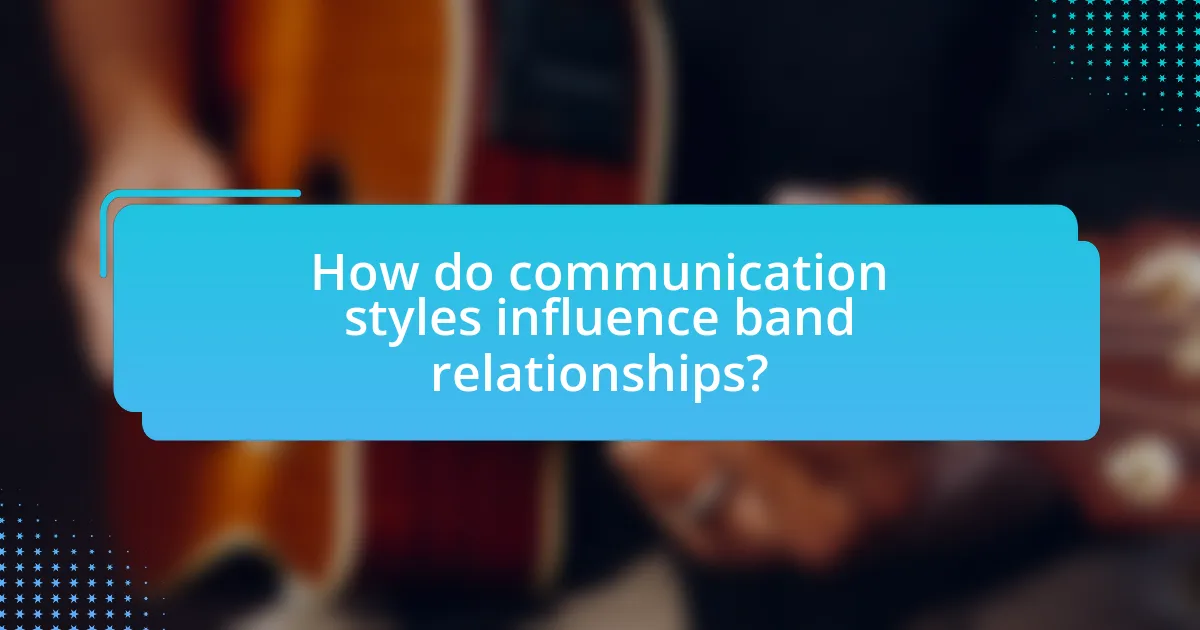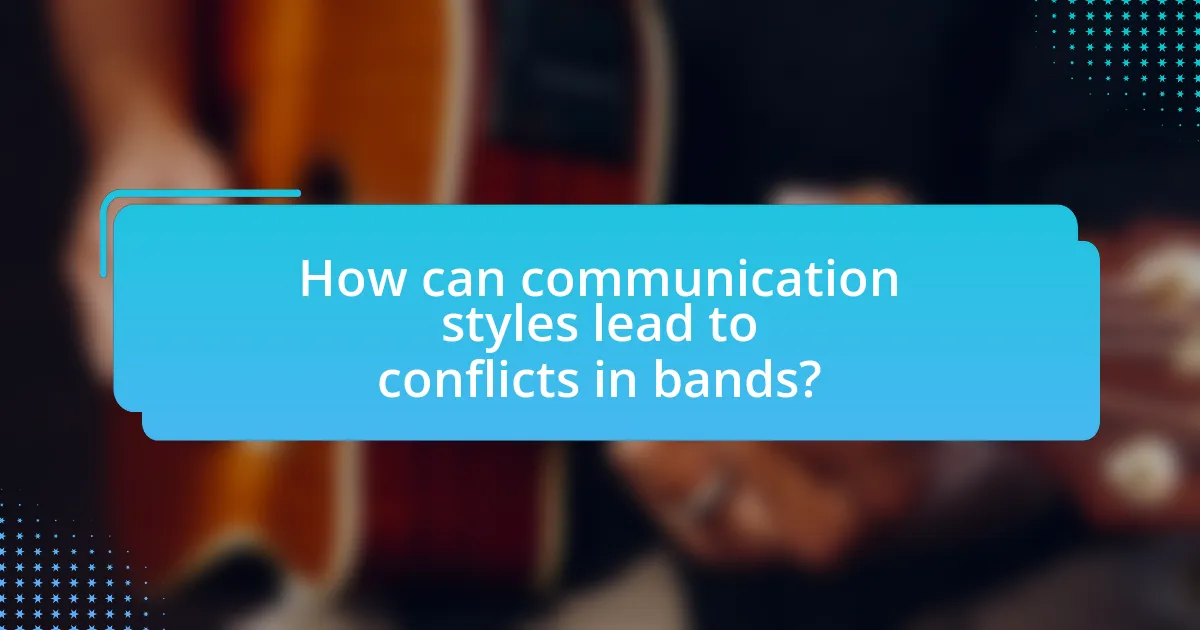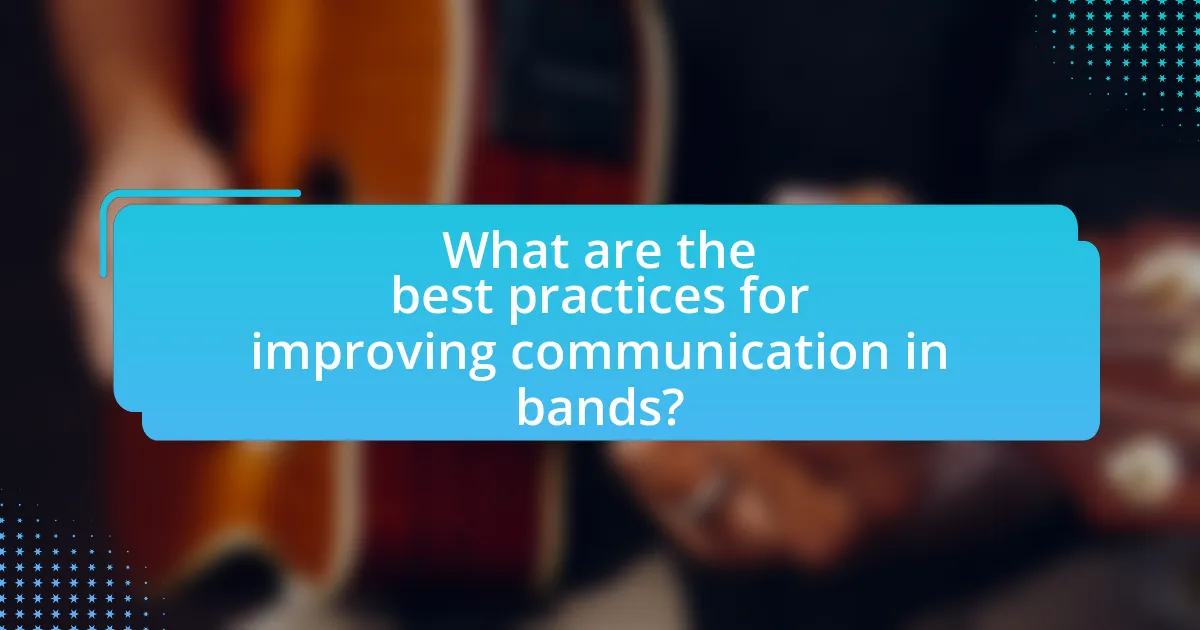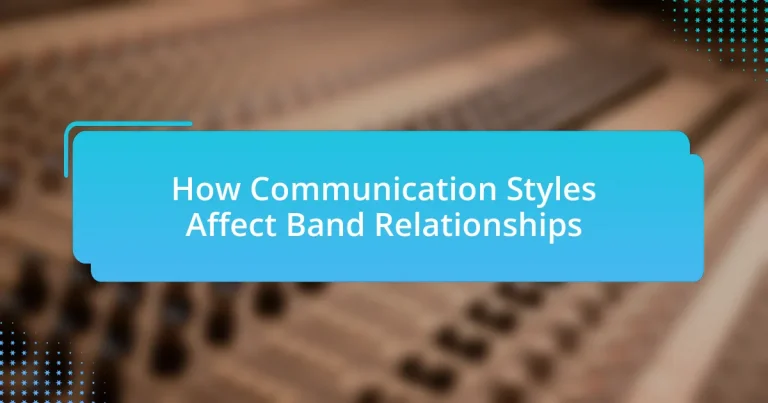The article examines how communication styles influence relationships within musical bands, highlighting the impact of assertive, passive, aggressive, and passive-aggressive communication on collaboration and conflict resolution. It emphasizes that effective communication fosters creativity and cohesion, while poor communication can lead to misunderstandings and decreased performance. Key strategies for improving communication include active listening, regular feedback, and establishing clear communication norms, all of which contribute to a more harmonious and productive band environment. The article also discusses the importance of self-awareness and empathy in enhancing interpersonal dynamics among band members.

How do communication styles influence band relationships?
Communication styles significantly influence band relationships by shaping interactions, collaboration, and conflict resolution. For instance, bands with members who employ open and assertive communication tend to foster a more cohesive environment, enhancing creativity and mutual respect. In contrast, bands where members utilize passive or aggressive communication styles may experience misunderstandings and tension, leading to conflicts that can disrupt harmony and productivity. Research indicates that effective communication is crucial for team dynamics; a study published in the Journal of Applied Psychology found that teams with high communication quality reported better performance and satisfaction. Thus, the communication styles adopted by band members directly impact their relationships and overall success.
What are the different communication styles commonly found in bands?
Bands commonly exhibit four different communication styles: assertive, passive, aggressive, and passive-aggressive. Assertive communication involves expressing thoughts and feelings openly while respecting others, fostering a collaborative environment. Passive communication often leads to misunderstandings, as individuals may avoid expressing their needs, resulting in frustration. Aggressive communication can create conflict, as it involves dominating conversations and disregarding others’ opinions. Passive-aggressive communication combines indirect resistance with avoidance, leading to tension and unresolved issues. These styles significantly impact band dynamics, influencing collaboration, creativity, and overall relationships among members.
How does assertive communication impact band dynamics?
Assertive communication positively impacts band dynamics by fostering open dialogue and mutual respect among members. This communication style encourages individuals to express their thoughts and feelings clearly while also valuing the perspectives of others, which can lead to enhanced collaboration and creativity within the group. Research indicates that bands with assertive communicators experience fewer conflicts and greater satisfaction, as members feel heard and understood, ultimately contributing to a more cohesive and productive environment.
What role does passive communication play in band relationships?
Passive communication often leads to misunderstandings and unresolved conflicts in band relationships. This communication style can result in members not expressing their needs or concerns, which may create tension and resentment over time. Research indicates that bands with open communication tend to have better cohesion and collaboration, while those relying on passive communication may struggle with decision-making and creativity. For instance, a study published in the Journal of Music Psychology found that effective communication, including assertiveness, significantly enhances group dynamics and overall performance quality in musical ensembles.
How can aggressive communication affect collaboration within a band?
Aggressive communication can significantly hinder collaboration within a band by creating an environment of tension and conflict. When band members engage in aggressive communication, it often leads to misunderstandings, decreased morale, and a lack of trust among members. Research indicates that teams with high levels of conflict experience a 50% decrease in performance due to the negative impact on group cohesion and collaboration. Furthermore, aggressive communication can stifle creativity, as members may feel reluctant to share ideas or feedback for fear of backlash, ultimately undermining the collaborative process essential for musical success.
Why is understanding communication styles important for band members?
Understanding communication styles is crucial for band members because it enhances collaboration and minimizes conflicts. Effective communication fosters a positive environment where members can express their ideas and feedback openly, leading to improved creativity and cohesion. Research indicates that teams with diverse communication styles can achieve higher performance levels, as they leverage different perspectives to solve problems and innovate. For instance, a study published in the Journal of Applied Psychology found that teams that understood and adapted to each other’s communication preferences experienced a 25% increase in overall productivity. This evidence underscores the importance of recognizing and adapting to various communication styles within a band to strengthen relationships and achieve collective goals.
How can effective communication enhance creativity in a band?
Effective communication enhances creativity in a band by fostering an environment where members feel safe to share ideas and collaborate openly. When band members communicate effectively, they can express their thoughts, feedback, and suggestions without fear of judgment, leading to a more dynamic exchange of creative concepts. Research indicates that bands with strong communication skills often produce more innovative music, as members are more likely to build on each other’s ideas and explore diverse musical directions. For instance, a study published in the Journal of Creative Behavior found that teams with high levels of open communication reported greater creative output compared to those with poor communication practices. This demonstrates that effective communication not only strengthens relationships within the band but also directly contributes to enhanced creativity.
What are the consequences of poor communication among band members?
Poor communication among band members leads to misunderstandings, conflicts, and decreased collaboration. These issues can result in a lack of cohesion, which negatively impacts the band’s overall performance and creativity. For instance, a study published in the Journal of Music Psychology found that bands with effective communication reported higher levels of satisfaction and productivity compared to those with poor communication. Additionally, unresolved conflicts can lead to member turnover, disrupting the band’s stability and continuity.

How can communication styles lead to conflicts in bands?
Communication styles can lead to conflicts in bands by creating misunderstandings and misinterpretations among members. For instance, if one member prefers direct communication while another favors a more indirect approach, the direct communicator may perceive the indirect communicator as evasive or unengaged, leading to frustration. Research indicates that differing communication preferences can result in decreased collaboration and increased tension, as seen in a study published in the Journal of Applied Psychology, which found that teams with mismatched communication styles experienced higher levels of conflict and lower performance outcomes. This evidence underscores the importance of aligning communication styles to foster a harmonious band environment.
What are common sources of conflict related to communication styles?
Common sources of conflict related to communication styles include differences in directness, tone, and nonverbal cues. For instance, individuals who prefer direct communication may perceive indirect communicators as evasive or unclear, leading to misunderstandings. Additionally, variations in tone can create tension; a straightforward tone may be interpreted as harsh by someone who favors a more empathetic approach. Nonverbal cues, such as body language and eye contact, can also lead to conflict when one party misinterprets the other’s intentions. Research indicates that these differences can significantly impact group dynamics, as highlighted in studies on team communication effectiveness, which show that misalignment in communication styles often correlates with increased conflict and decreased collaboration.
How do misunderstandings arise from different communication approaches?
Misunderstandings arise from different communication approaches due to variations in expression, interpretation, and cultural context. For instance, direct communicators may perceive indirect communicators as evasive, while indirect communicators may view directness as harsh. Research indicates that 70% of workplace conflicts stem from miscommunication, highlighting the significant impact of differing styles. Additionally, cultural differences can exacerbate these misunderstandings, as norms around communication vary widely; for example, high-context cultures rely on implicit messages, whereas low-context cultures favor explicit communication. This divergence can lead to assumptions and misinterpretations, ultimately straining relationships within a band.
What strategies can be employed to resolve conflicts stemming from communication issues?
To resolve conflicts stemming from communication issues, active listening, clear expression of thoughts, and establishing common ground are effective strategies. Active listening involves fully concentrating on the speaker, which helps to understand their perspective and reduces misunderstandings. Clear expression of thoughts ensures that messages are conveyed accurately, minimizing the chances of misinterpretation. Establishing common ground fosters collaboration and encourages mutual respect, which can lead to more constructive discussions. Research indicates that effective communication strategies can significantly enhance team dynamics and reduce conflict, as highlighted in studies on group communication in collaborative environments.
How can bands create a positive communication environment?
Bands can create a positive communication environment by establishing clear communication norms and encouraging open dialogue among members. This approach fosters trust and collaboration, essential for effective teamwork. Research indicates that bands with defined communication protocols experience fewer conflicts and higher satisfaction levels, as members feel valued and understood. For instance, a study published in the Journal of Music Psychology found that bands that regularly engage in feedback sessions report improved cohesion and creativity, demonstrating the importance of structured communication in enhancing relationships within the group.
What practices can foster open communication among band members?
Practices that can foster open communication among band members include regular meetings, active listening, and establishing a safe space for feedback. Regular meetings allow members to discuss ideas and concerns, ensuring everyone has a voice. Active listening encourages members to fully engage with each other’s perspectives, which builds trust and understanding. Establishing a safe space for feedback means creating an environment where members feel comfortable sharing their thoughts without fear of judgment, which is crucial for honest dialogue. These practices are supported by research indicating that effective communication enhances collaboration and strengthens relationships within teams, as noted in studies on group dynamics and teamwork.
How can regular feedback improve communication within a band?
Regular feedback enhances communication within a band by fostering an environment of openness and trust. When band members provide and receive constructive feedback, they clarify expectations, address misunderstandings, and promote collaboration. This ongoing dialogue helps to align individual contributions with the group’s goals, ultimately improving overall performance. Research indicates that teams that engage in regular feedback sessions experience increased cohesion and satisfaction, as members feel valued and heard, which is crucial for effective collaboration in a musical setting.

What are the best practices for improving communication in bands?
The best practices for improving communication in bands include establishing regular meetings, encouraging open dialogue, and utilizing technology for coordination. Regular meetings allow band members to discuss ideas, resolve conflicts, and plan future activities, fostering a collaborative environment. Encouraging open dialogue ensures that all members feel comfortable sharing their thoughts and concerns, which can lead to better understanding and stronger relationships. Utilizing technology, such as group messaging apps or project management tools, streamlines communication and keeps everyone informed about schedules and tasks. These practices are supported by studies indicating that effective communication enhances teamwork and reduces misunderstandings, ultimately leading to a more cohesive band dynamic.
How can band members identify their own communication styles?
Band members can identify their own communication styles by reflecting on their interactions and seeking feedback from peers. Self-assessment tools, such as personality tests or communication style inventories, can provide insights into individual preferences and tendencies. Research indicates that understanding one’s communication style enhances collaboration and reduces misunderstandings within groups, as highlighted in studies on team dynamics. By actively engaging in discussions about communication preferences and observing their responses in various situations, band members can gain clarity on their unique styles and improve overall group cohesion.
What tools can help band members assess their communication effectiveness?
Band members can use tools such as communication assessment surveys, feedback apps, and video recording analysis to assess their communication effectiveness. Communication assessment surveys, like the Myers-Briggs Type Indicator, help identify individual communication styles and preferences, facilitating better understanding among members. Feedback apps, such as 15Five, allow for real-time feedback and reflections on communication practices, promoting continuous improvement. Video recording analysis enables band members to review their interactions during rehearsals or performances, providing concrete examples of communication strengths and weaknesses. These tools collectively enhance awareness and foster more effective communication within the band.
How can self-awareness enhance interpersonal communication in a band?
Self-awareness enhances interpersonal communication in a band by allowing members to understand their own emotions, strengths, and weaknesses, which leads to more effective interactions. When band members are self-aware, they can express their thoughts and feelings clearly, reducing misunderstandings and fostering a supportive environment. Research indicates that self-awareness is linked to improved emotional intelligence, which is crucial for navigating the dynamics of group settings. For instance, a study published in the Journal of Applied Psychology found that teams with higher emotional intelligence, stemming from self-awareness, demonstrated better communication and collaboration, ultimately leading to enhanced performance.
What techniques can be used to adapt communication styles for better collaboration?
Techniques to adapt communication styles for better collaboration include active listening, adjusting tone and language, and utilizing non-verbal cues. Active listening involves fully concentrating on the speaker, which fosters understanding and respect, leading to more effective exchanges. Adjusting tone and language to match the audience enhances relatability and clarity, making it easier for team members to engage. Non-verbal cues, such as eye contact and body language, reinforce verbal communication and help convey openness and support. Research indicates that teams employing these techniques experience improved collaboration and productivity, as effective communication is crucial for successful teamwork.
How can active listening improve band relationships?
Active listening can significantly improve band relationships by fostering open communication and mutual understanding among members. When band members actively listen to each other, they demonstrate respect for differing opinions and ideas, which can lead to more effective collaboration. Research indicates that effective communication, including active listening, enhances group cohesion and reduces conflicts, as it allows individuals to feel heard and valued. For instance, a study published in the Journal of Applied Psychology found that teams with strong communication skills, including active listening, reported higher satisfaction and performance levels. This evidence supports the notion that active listening is crucial for building trust and enhancing interpersonal dynamics within a band.
What role does empathy play in effective band communication?
Empathy plays a crucial role in effective band communication by fostering understanding and collaboration among members. When band members practice empathy, they are better able to recognize and appreciate each other’s perspectives, which enhances interpersonal relationships and reduces conflicts. Research indicates that teams with high levels of empathy experience improved communication, as members feel more valued and understood, leading to a more cohesive group dynamic. For instance, a study published in the Journal of Applied Psychology found that empathetic communication significantly correlates with team performance and satisfaction, highlighting its importance in collaborative environments like bands.
What practical tips can bands implement to enhance communication?
Bands can enhance communication by establishing regular meetings to discuss goals and concerns. These meetings create a structured environment for members to express their thoughts, ensuring everyone is on the same page. Additionally, utilizing digital communication tools, such as group chats or project management apps, allows for real-time updates and feedback, which can improve collaboration. Research indicates that effective communication within teams leads to higher performance and satisfaction, as seen in studies on group dynamics in musical ensembles. By implementing these strategies, bands can foster a more cohesive and productive working relationship.
















